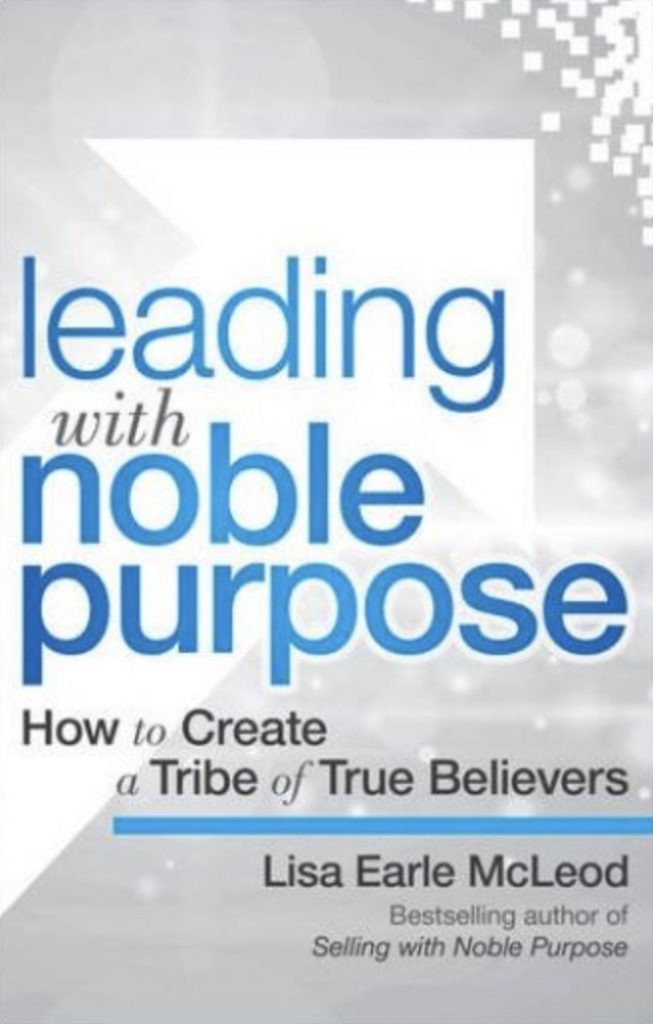Key Quote:
“Telling ‘meaning stories’ that dig into why your company exists, the difference you’re making in the world, and in your customer’s lives gives employees something to feel proud of and involved in (p. 21).” — Lisa Earle McLeod
Key Points and Concepts
What is Noble Purpose?
Noble Purpose is a clear and simple statement that explains the impact your organization has on its customers.
McLeod created this concept to help leaders accelerate growth and differentiate their businesses from competition.
A good Noble Purpose is specific and customer focused (p. 55).
Your Noble Purpose should propel your company’s strategy and mission. It doesn’t replace or work against it.
If your Noble Purpose is simple, clear, and customer focused, it can act as a compass and guide leaders through daily decision making. If something doesn’t align with or support your Noble Purpose, the answer is an obvious no (p. 25).
What Noble Purpose Isn’t
Noble Purpose isn’t charity. It’s designed to make your company money and engage everyone in the organization in driving revenue (p. 27).
It’s not a flavor of the month or marketing campaign. Noble Purpose doesn’t change with outside circumstances. It’s the core and driving force of an organization (p. 148).
Your Noble Purpose isn’t meant to be an HR program. Its main focus is on competitiondifferentiation and customer impact (p. 106).
How to Create your Noble Purpose
Claim your purpose: clarify who your customers are and prioritize constituents (p. 203).
Prove your Noble Purpose: create your narrative and prove it by using stories and data that show the impact your purpose has and what it looks like in action (p. 207).
Launch your Noble Purpose: help your team internalize your strategy by rolling it out across all departments. Have teams identify the impact they have and how their work fits into the larger whole and their own aspirations (p. 211).
Operationalize your Noble Purpose: bring your customers to life in every corner of your organization using visuals and stories. Bring your customers front and center internally and then start to infuse it into external messaging and marketing (p. 217).
Leading with Noble Purpose: How to Create a Tribe of True Believers
Imbed your Noble Purpose: establish systems and processes for ongoing reinforcement by looking at performance development and compensation. Think creatively about customer feedback and retention, and how you’re going to create a legacy organization (p. 223).
FCm Travel Solutions, a corporate travel management company, applied a Noble Purpose to their company and they now have some of the highest employee engagement scores in the world. Here is their advice on rolling out your own purpose (p. 23): You have to decide who you are and who you are not. This frees people of the need to operate in a transactional space. If you can get people feeling like they have a purpose at work, it has quite an impact.
Move quickly to get it imbedded within your organization. If everyone is saying the statement, that’s a massive win.
Examples of Success
Blackbaud (cloud company) – “We accelerate your Noble Purpose”. After applying their Noble Purpose, Blackbaud’s stock rose from $37 a share to $60 (p. 12).
Blackbaud’s CEO focused on actual customer impact stories during meetings as opposed to leading with numbers (p. 9).
CVS – “Helping people on their path to better health”. When CVS launched its “let quit together” campaign and stopped selling tobacco products, it initially gave up $2 billion in revenue (p. 175).
They made headlines in every newspaper in the country and have been lauded by medical professionals and business journals alike. Industry analysts believe that CVS will quickly replace their tobacco income with higher-profit tobacco addiction and clinic services (p. 176).
Hootsuite (SaaS company) – “We empower our clients to turn messages into meaningful relationships”. Hootsuite has grown 56,000 percent over the past five years (p. 7).
Explorys (health care analytics) – “We unlock the power of BIG DATA to improve healthcare for everyone”.
The year after they launched their purpose with their team, they grew revenue by 53 percent (p. 7).
Popeye’s Louisiana Kitchen – “Inspire servant leaders to achieve superior results”. Since releasing their purpose, Popeye’s has experienced seven years of growth.
Market share has grown from 14 to 21 percent, stock price is up 450 percent, and the profitability of restaurants has improved 40 percent (p. 141).
Examples of Failure
Blockbuster – By focusing on profit instead of purpose, Blockbuster became a dinosaur. They were talking about putting more candy in the checkout aisle while Netflix was busy reimagining the way people watch movies (p. 98).
Monster.com – Monster’s inability to keep up with new competition such as LinkedIn and Indeed was the symptom of a deeper root cause. What actually happened was that they lost their purpose. They stopped talking about job seekers and helping people find better lives. They focused solely on increasing earnings (p. 4).
Volkswagen – An extreme example of a company losing its sense of purpose and chasing short-term gain. Prior to committing fraud and giving false readings during emissions testing, Volkswagen’s main objective was to surpass Toyota in revenue, not in quality. They created a culture were lying to beat their competition became more important than following the law.
The fraud will cost Volkswagen an estimated minimum of $34.5 billion (p. 125).
Creating a “money story” and focusing only on meeting your numbers and making profits doesn’t inspire, it deflates.
Mcleod, L.E. (2016). Leading With Noble Purpose: How to Create a Tribe of True Believers. New Jersey: Wiley & Sons, Inc.

Noble Purpose isn’t charity. It’s designed to make your company money and engage everyone in the organization in driving revenue. It’s not a flavor of the month or marketing campaign. Noble Purpose doesn’t change with outside circumstances. It’s the core and driving force of an organization.
Example of Success: Blackbaud (cloud company) – “We accelerate your NoblePurpose”. After applying their Noble Purpose, Blackbaud’s stock rose from $37 a share to $60.
Example of Failure: Volkswagen – An extreme example of a company losing its sense of purpose and chasing short-term gain. Prior to committing fraud and giving false readings during emissions testing, Volkswagen’s main objective was to surpass Toyota in revenue, not in quality. They created a culture were lying to beat their competition became more important than following the law.
